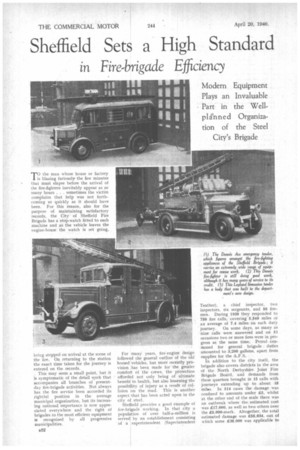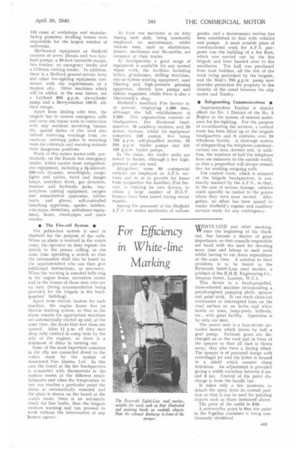Sheffield Sets a High Standard
Page 70

Page 71

If you've noticed an error in this article please click here to report it so we can fix it.
in Fire-brigade Efficiency
TTithe man whose house or factory ips blazing furiously the few minutes that must elapse before the arrival of the fire-fighters inevitably appear as so many hours . . . sometimes the victim complains that help was not forthcoming so quickly as it should have been. For this reason, also for the purpose of maintaining satisfactory records, the City of Sheffield Fire Brigade has a stop-watch fitted to each machine and as the vehicle leaves the engine-house the watch is set going,
being stopped on arrival at the scene of the fire. On returning to the station the exact time taken for the journey is entered on the records.
. This may seem a small point, but it is symptomatic of the detail work that accompanies all branches of presentday fire-brigade activities. Not always has the fire service been accorded its rightful position in the average municipal organization, but its increasing national importance is now appreciated everywhere and the right of brigades to the most efficient equipment Is recognized by all progressive municipalities.
For many years, fire engine design followed the general outline of the old horsed vehicles, but more recently provision has been made for the greater comfort of the crews, the protection afforded not only being of ultimate benefit to health, but also lessening the possibility of injury as a result of collision on the road. This is another aspect that has been acted upon in the city of steel.
Sheffield provides a good example of fire-brigade working. In that city a population of over half-a-million is served by an establishment consisting of a superintendent (Superintendent
Teather), a chief inspector, two inspectors, six sergeants, and 56 firemen. During 1939 they responded to 750 fire calls, covering 5,549 miles or an average of 7.4 miles on each duty journey. On some days, as many as nine calls were answered and on 51 occasions two or more fires were in progress at the same time. Petrol consumed for general brigade duties amounted to 3,200 gallons, apart from supplies for the A.F.S.
In addition to the city itself, the brigade also covers districts in the area of the North Derbyshire Joint Fire Brigade Board, and demands from these quarters brought in 15 calls with journeys extending up to about 18 miles. In 514 cases the damage was confined to amounts under £5, whilst at the other end of the scale there was an outbreak where the estimated cost was £17,000, as well as two others over the £5,000-mark. Altogether, the total estimated damage was £55,634, out of which some £38,000 was applicable to
144 cases at workshops and manufacturing premises; dwelling houses were responsible for the largest number of outbreaks.
Mechanical equipment at Sheffield consists of seven Dennis and two Leyland pumps, a 90-foot turntable escape, two tenders, an emergency tender and a Hillman visiting tender. In addition, there is a Bedford general-service lorry and other fire-fighting equipment consistent with the requirements of a modern city. Other machines which will he added, in the near future, are a Leyland 800 g.p.m. six-cylinder pump and a Merryweather 100-ft. allsteel escape.
Apart from dealing with fires, the brigade has to answer emergency calls and carry out rescue work in connection with any accident involving human life; special duties of this kind also include removing wreckage from sue roadway, assisting police in searching roofs for criminals and rescuing animals from dangerous positions.
Work of this nature makes calls, particularly, on the Dennis Ace emergency tender, which carries most comprehensive equipment, including a 31-kilowatt 200-volt dynamo, searchlights, cargolights and cables, hand and danger lamps, acetylene flares, gas detectors, tramcar and hydraulic jacks, oxyacetylene cutting equipment, oxygen and resuscitation apparatus, rubber boots and gloves, self-controlled breathing apparatus, spades, ladders, wire ropes, stretchers, ambulance equipment, hoses, stand-pipes and spare nozzles.
• The Fire-call System • The police-box system is used in Sheffield for the purpose of fire calls. When an alarm is received in the watch room, the operator on duty repeats the details to the person calling, at the same time operating a switch so that the information shall also be heard by the superintendent who can then give additional instructions, as necessary. When the warning is sounded bells ring in the engine house, recreation rooms and in the houses of those men who are on duty (living accommodation being provided for the brigade in the headquarters' building).
Apart from electric heaters for each machine, the engine house has an electric starting system, so that as The alarm sounds the appropriate machines are automatically started up and, at the same time, the doors that face them are opened. After 11 p.m. all duty men sleep fully clothed in camp beds by the side of the engines, so there is a minimum of delay in turning out.
Some of the most important concerns in the city are connected direct to the watch room by the system of Associated Fire Maims, Ltd. In this case the board at the fire headquarters is connected with thermostats in the various rooms at the different establishments and when the temperature in any one reaches a particular point the alarm is automatically sounded and the place is shown on the board at the watch room; there is an automatic check for line faults, thus the, brigade receives warning and can proceed to work without the intervention of any human agency. At least one mechanic is on duty during each shift, being constantly employed on maintenance, whilst various men, such as electricians, joiners, mechanics and tin-smiths, are occupied at their trades.
At headquarters a good range of equipment is available for any normal repair work, the facilities including lathes, grindstones, drilling machines, oxy-acetylene welding equipment, sand blasting and high-pressure greasing apparatus, electric tyre pumps and similar requisites, whilst there is also a blacksmith's shop.
Sheffield's Auxiliary Fire Service is, at present,. employing 1,680 • men, although the . full establishment is 2,500. This organization consists • of headquarters, five divisional • headquarters, 18 auxiliary stations,and 20 action stations, whilst its equipment comprises 240 pumps, five being 750 g.p.m. self-propelled models, 70 330 g.p.m. trailer pumps and 165 120 g.p.m. trailer pumps.
In the main,, the trailer units are towed by lorries, although a few highpowered cars are used.
Altogether, some 90 commercial vehicles are employed on A.F.S. services and so as to provide for losses from resignation the Auxiliary Fire Service, is training its own drivers, to whom a large • number of H.G.V. licences have been issued during recent months.
Among the personnel of the Sheffield A.F.S, are motor mechanics of various grades, and a maintenance section has been established to deal with vehicles and pumps. A most notable piece of constructional work for A.F.S, purposes was the building of a fire float, which was carried out by the fire brigade and later handed over to the auxiliaries. The hull was purchased from boat builders, all the rest of the work being performed by the brigade, and the float's 750 g.p.m. pump now provides protection for property in the vicinity of the canal between the city centre and Tinsley.
• Safeguarding Communications • Superintendent Teather is district officer for No'. 1 District of the No. 2 Region in the system of mutual assistance for fire-fighting. For the purpose of co-ordinating the services, a control room has been fitted up at the brigade headquarters and it contains over 20 telephone booths. A thorough system of safeguarding the telephone communications has been devised and, in addition, the numbers of half the telephone lines are unknown to the outside world, so that a proportion will always remain free for working outgoing calls.
The control room, which is situated at the brigade headquarters, is constantly manned by the A.F.S., so that, in the case of serious damage, vehicles could speedily be rushed to the points where they were most needed. Altogether, no effort has been spared to render Sheffield's regular and auxiliary services ready for any contingency.




































































































